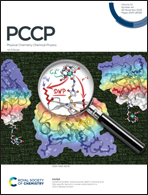π-Orbital Yin–Yang Kagome bands in anilato-based metal–organic frameworks†
Abstract
π-Orbital bonding plays an important role not only in traditional molecular science and solid-state chemistry but also in modern quantum physics and materials, such as the relativistic Dirac states formed by bonding and antibonding π-bands in graphene. Here, we disclose an interesting manifestation of π-orbitals in forming the Yin–Yang Kagome bands, which host potentially a range of exotic quantum phenomena. Based on first-principles calculations and tight-binding orbital analyses, we show that the frontier π2- and π3-orbitals in anilato-based metal–organic frameworks form concurrently a conduction and valence set of Kagome bands, respectively, but with opposite signs of lattice hopping to constitute a pair of enantiomorphic Yin and Yang Kagome bands, as recently proposed in a diatomic Kagome lattice. The twisted configuration of neighboring benzene-derived organic ligands bridged by an octahedrally O-coordinated metal ion is found to play a critical role in creating the opposite sign of lattice hopping for the π2- versus π3-orbitals. Our finding affords a new material platform to study π-orbital originated quantum chemistry and physics.



 Please wait while we load your content...
Please wait while we load your content...